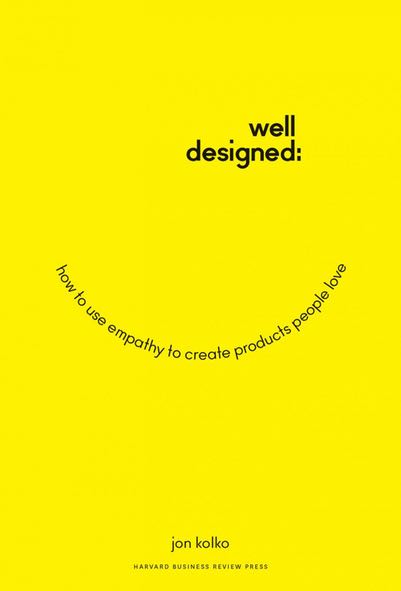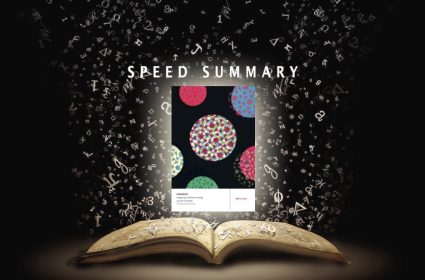Speed Summary: Well Designed – How to Use Empathy to Create Products People Love


- Well Designed: How to Use Empathy to Create Products People Love
- Author: Jon Kolko
- Publisher: Harvard Business Review Press
- Publication: 2014
Here’s how to use empathy to create products people love.
Generate empathy insights.
An empathy insight is an insight (an unexpected shift in understanding (that explains and predicts behaviour)) that focuses on how people feel and why they feel it
Empathy Insight: People feel…(name the emotion expressed by person/people interviewed) because… (name the thoughts, experiences, and behaviours they mention)
In Well Designed: How to Use Empathy to Create Products People Love, thought-leader in design Jon Kolko argues that feeling and experiencing the emotional world of the person you are designing for (aka empathy) is the key to successful design.
This means understanding
- People’s goals (we are emotionally invested in our goals)
- People’s expectations (expectations determine our emotional responses)
- People’s emotional response to how something ‘feels’ when it is used.
This question what does it feel like to… (select, purchase, use or dispose of a product) lies at the heart of empathic research. And for Kolko, this emotional insight is what is missing from so much new product development. Instead focus on specs, features, aesthetics and utility – but miss out on what it feels like to be the person using the product or service. But the emotional response is key to business success – since it determines continued use, loyalty, repurchase, and recommendation.
Kolko is a fan of a ‘design-thinking’ approach to innovation, which begins with empathy and proceeds by designing from the point of view of the person you are designing for. The book provides a personal take on the design thinking process, but two key elements stand out; the idea that empathy is a learned skill with techniques that can be mastered, and the value of an Emotional Value Proposition.
It is true that some people are naturally more empathic than others – they have the capacity to feel what we are feeling and see the world from our perspective. Women tend to be more empathic than men. Friendly (‘agreeable’) people may be more empathic, whilst narcissistic people less so. Kolko’s point is that we can learn to be more empathic. There are two basic techniques – one – to be with the person, and – two – to be the person.
Do you feel me?
Empathy works in two ways – one is automatic, and the other is intentional.
- Automatic empathy is the tendency for our emotions to converge with those of people around us. Moods and emotions – from happiness to sadness, to anxiety, fear and panic are socially contagious. What appears to happen is that we automatically mirror and synchronise our facial expressions and other non-verbal behaviour as we interact with others, and this behavioural mirroring may feedback and influence our own emotional state, resulting in emotional convergence. Psychologists call this emotional contagion. What’s key for this kind of automatic empathy to occur is that we are in close physical proximity to the other and attentive to their facial expressions. Kolko suggests we go for a drive with the person – you’re in close proximity – and you’re likely to catch their emotion. If you want to catch their emotion, you have to be prepared to catch their cold. Another solution is to accompany someone as they use a product or service. On the other hand, Kolko notes that surveys kill empathy – empathy derives from human to human contact – remove the contact, you remove the empathy. Bottom line, to build empathy spend time together, be with the person – in close proximity.
- Intentional empathy is about perspective taking, it’s about shoe-shifting – deliberately putting yourself metaphorically into the shoes of the other, and seeing the world from their perspective. Kolko suggests role-playing and participant observation (where you participate as a member of your target market, with members of your target market) as ways to build this kind of intentional empathy. Your goal here is to be able to describe what it feels like to be the person, by being the person. So rather than go on a ‘research safari’ to see people in context interacting a product, you want to be the person using the product. Empathy is first-person perspective research.
Emotional Value Proposition
Most brands have some kind of value proposition – a promise to produce value for a customer – something that they’ll be able to do, or do better, after buying the product. For example, Google’s value proposition includes helping people search for information. Kolko suggests that a value proposition is a good way to look at your job.
[table id=1 /]
Whilst value propositions such as this are valuable, they tend to be rather functional – helping people do stuff, rather than feel things. Kolko suggests brands should also have an emotional value proposition – something people will feel after using or acquiring your product that they couldn’t feel before using or acquiring it.
For example, the EVP – emotional value proposition – of a wearable wellbeing tracker “After using the tracker, people will feel more connected with their body rhythms and feel more connected with their mental health”. The key is that the EVP focuses on the emotional outcomes – how people feel as opposed to what they do. Although Kolko doesn’t specify the emotional feelings innovators should target, a good start could be the 10 feelings psychologists use to measure happiness internationally – the frequency you feel these five positive feelings – active, determined, attentive, inspired, alert vs. the frequency you feel these negative feelings – afraid, nervous, upset, hostile, ashamed (I-PANAS-SF).
More generally, the format of an empathy value proposition is
After using [product] people will feel more [positive emotion] (and/or will feel less [negative emotion]).
The Brand Genetics Take
Empathy is having a moment in consumer research and innovation – there is talk of ‘Big Empathy‘ (as opposed to Big Data), ‘Peak Empathy‘ – and even counterviews ‘Against Empathy‘. Kolko does a good job in providing professionals with practical tools and techniques to walk the empathy talk in the shoes of the other. If there’s a criticism of the book it’s that it extends beyond its self-imposed remit of explaining ‘How to Use Empathy to Create Products People Love’ and by articulating a design-thinking framework it somewhat dilutes its own value proposition. For example, it would have been useful to cover how to conduct empathy interviews, and how to practice empathic listening. Nevertheless for both qualitative researchers and humanistic designers, Well Designed is a well worth the read.




